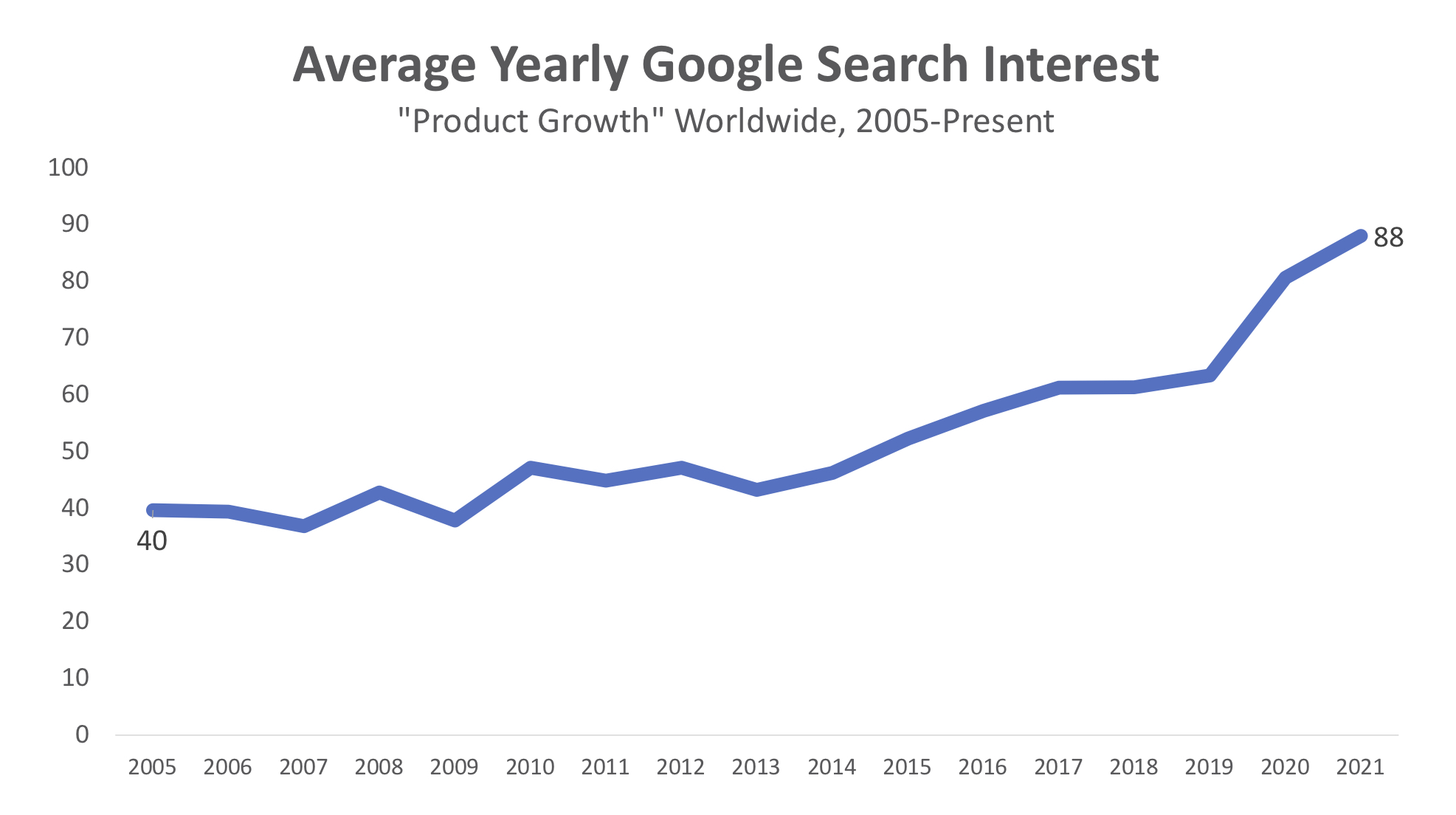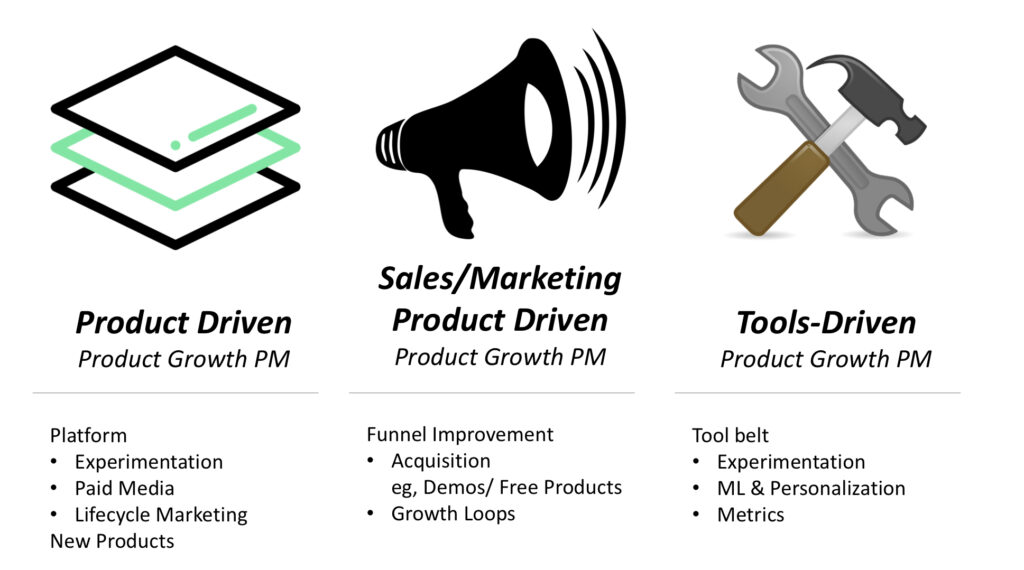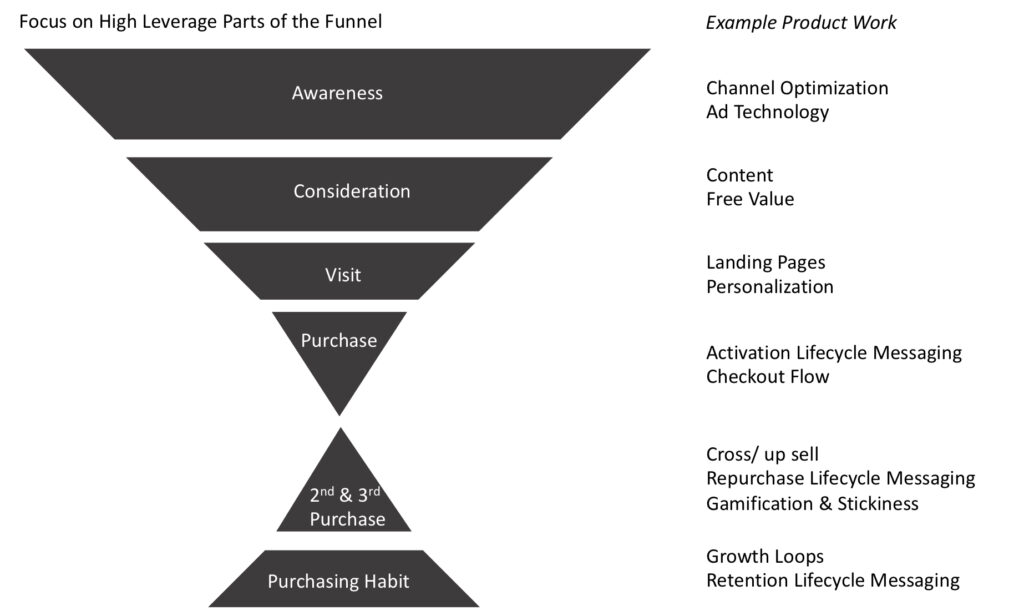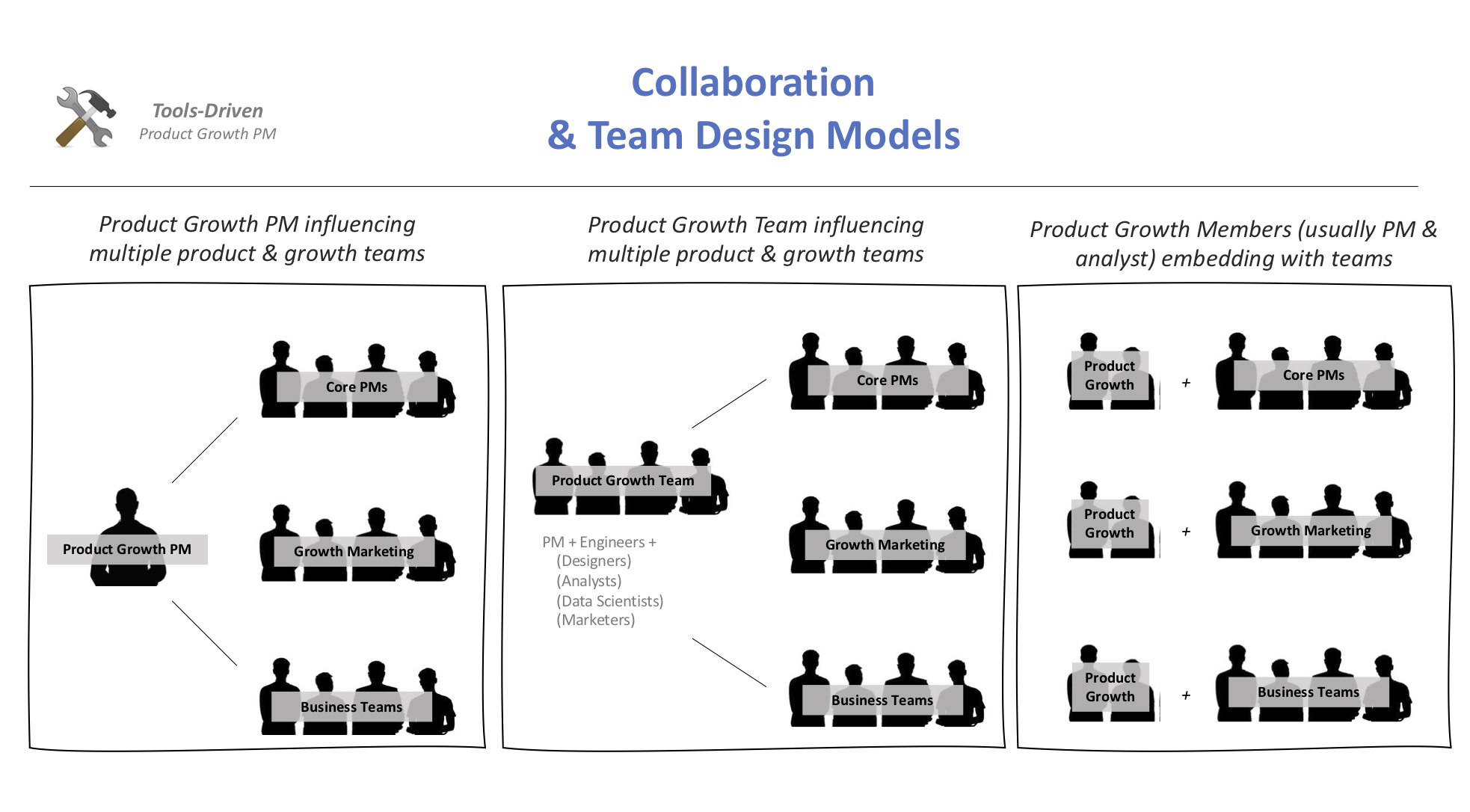Detailing the work of the different types of product teams focused on product growth
If growth hacker was a buzzword in 2011, “product growth” could be construed as a similar buzzword for 2021. In this post, I try to breakdown the buzzword to get a grasp over what Product Growth could mean for those PMs.

What product growth is not
Product growth is different from product-led growth. Almost all product teams aspire to help drive product-led growth. It is a topic that is important for product people to evangelize. It helps the reputation and resourcing of the product team. However, some product teams have product managers and designers with titles like, “Product Manager, Product Growth” and “Product Designer, Growth.” In this post, I try to define specifically what work those people do.
Product growth is also different from product growth strategy. That is a topic that many different groups – including executives, strategy, finance, and BizOps – should contribute to. The strategy is the markets, segments, and problems to solve in the context of the competitive environment. Product growth is what the product teams working in growth do to execute on that strategy.
The closest thing to product growth is growth product management. I will argue in this piece, however, that traditional conceptualizations of growth product management is but a segment of what product growth product managers can focus on. More on this to come.

Why you should care
Why should you care about what product growth is?
1/ This role is popping up at many of the fastest growing tech companies:
- Facebook (valued ~$968B)
- Paypal (valued at ~$346B)
- Square (valued ~$108B)
- Canva (valued ~$30B)
- Dropbox (valued ~$12B)
- Policygenius (valued ~$600M)
Generally, it is the type of role that is seen in companies scaling after they have achieved product market fit.
2/ The area has not been defined on the web comprehensively. The closest is content about subsets of product growth. Although a ton of that content is awesome, it is distinct:
- This Product School talk from Facebook Core PM Jake Strich
- This Product School talk from Dropbox Growth PM Willie Tran
- This Product School talk from Microsoft Senior PM Sinduja Ramanujam
- This Product School talk from Airbnb PM Pratik Shah
- This Eleken article on Growth Product Managers
- This Product-Led Growth Collective article on The Rise of the Growth Product Manager
3/ Learning about a role (that does not exist at your company) is a surprisingly useful technique to imagine work streams, work products, or initiatives that (you or) your company could take on.
The Archetypes
Like any role, it is industry, company, stage, and people specific; each of those four layers is going to color the following generalizations to paint any specific product growth PM’s role. B2B and B2C product growth PMs, in particular, tend to have different work. But despite those differences, after my research, I would argue in 2021 we can categorize product growth PMs into three broad buckets. Some product growth PMs, of course, do two, or all three, of these jobs.

“Product Driven Product Growth PM”
Generally, product driven product growth PMs lead dev teams to develop platforms or new products to drive growth. Within the platform bucket, the most common types of platforms these product growth PMs build are products that help other teams implement growth strategies. One of the common areas is an experimentation platform. This allows all sorts of teams plug in and have an interface for results read-outs. It provides a substrate layer for the whole company to drive product growth.
Two other common categories of platform products these product growth PMs build are growth marketing related. The first is paid media platforms. These are platforms to enable the paid media teams at the company to compete more effectively. In D2C companies, this type of technology is table stakes to compete in the fierce auctions. At thredUP, we built a platform to adjust our bids and budgets in Facebook, Google, and Pinterest. Other companies build platforms to build ads, or buy ads from proprietary networks.
The second growth marketing related platform these product growth PMs tend to work on is lifecycle marketing platforms. These products provide tools for marketing managers to segment, change copy, and timing, of key messages through channels like in-app notifications, push notifications, and email. These platforms also help measure results.
The final most common sub-archetype of product driven product growth PMs is those who build new products to drive growth. These are often in special projects teams or other skunkworks groups. By being a small separate team, they can move quickly and into new areas.
“Sales/ Marketing Product Driven Product Growth PM”
The vast majority of pre-existing content on growth product management focuses on this type of product growth. These types of growth PMs sit at the intersection of marketing and product. Most of these types of PMs identify growth levers and build products via testing around them to continually improve metrics. This is spiritually similar to the advertised role at Square, where the Job description cites, “you’ll build growth product experiences and infrastructure in order to grow the business internationally.”

They often lead dev teams to drive an experimentation roadmap against funnel metrics. In this way, they often solve problems for the marketing team, like lower conversion rates at part of a funnel, or by building a low customer acquisition cost engine through a free product. They might create new lead generation websites. A B2B product growth PM may build free tools that generates leads for their paid product. They may even develop completely new channels for selling a product, like the role at PolicyGenius. The product growth PM often adds value by helping provide structure for the team to decide amongst all this potential work, as highlighted by Microsoft Senior PM Sinduja Ramanujam.
These types of PMs may also help build growth loops within the product to increase stickiness and retention. The role at Paypal, for instance, seeks, “keen understanding of growth loops and the value of a flywheel engine.” The team at Dropbox has become famous for driving hockey-stick growth with its referral program. As their JDs emphasize, “You know every step of the user funnel.” It is not uncommon to see these PMs focused on a metric like orders per customer per year.
“Tools Driven Product Growth PM”
This type of PM has perhaps been pioneered and popularized by Facebook’s Product Growth team. “Partnering with Product Management, Engineering, Design, Content Strategy and Data Science,” becomes a critical role for this type of PM. They are often enhancing a large product team with more PM horsepower in the areas of experimentation, metrics, ML & personalization. That seems to be the job description at Canva.

What’s unique about this type of PM versus the other two is this one often partners with other PMs who own the key product areas growth is being focused on. The other two PMs manage product areas. One form of this type of growth PM is highlighted in this Product Chat explainer. The PM focuses on business metrics and leads a team of developers to help build features to drive business metrics. In that configuration, three other core product teams focused on building features to solve user problems.
Another version of this type of product growth PM is highlighted by Ragini Vaid at Start It Up. This type of PM may be the figurehead for experimentation at the company. As the Product Coalition describes it, this type of PM may be more tactics and short-term focused. They are trying to get experimental test results that push forward metrics. Sometimes, like at GitLab, these PMs do not lead engineering teams.
Yet another configuration is when the product growth team is embedded with product teams. The product growth PM and analyst add value to the team by structuring metrics in the form of funnels or equations. This growth model can often help the rest of the team understand the components of the broader high-level metric that they can affect with different actions. This type of work is what the Udacity nanodegree appears to focus on.
Appendix: Assorted Other Topics
Adjacent PMs
There are several PMs that are slightly adjacent to growth PMs:
Core Product PMs
PMs that focus on owning a specific part of the product are different from product growth PMs, as they are focused on a core product area. Many core PMs certainly use parts or all of the growth PM toolkit.
Data PMs
PMs that focus on making data digestible and usable by business stakeholders typically have their north star as data usability. Some senior product growth PM leaders have data PMs under their umbrella. But the data PM is usually building the data platform products, which enable the product growth teams to operate more efficiently, instead of the product growth itself.
Backend Platform PMs
PMs that develop backend infrastructure for other teams within their company to use are ubiquitous. They often build the enabling tools. Because they are similar to growth platform PMs, who are building paid media and lifecycle marketing systems, they often share teams. But the key results for these PMs are not product growth but internal team usability.
All three of these types of PMs may appear in product growth teams because they enable the team.
Similarities to other PMs
Many of the skills which PMs must have growth PMs must also have and regularly tap into as tools for working with their teams:
- User segmentation
- Focus on user problems/needs & solving them
- Establishing metrics to measure progress
- Driving outcomes not output
Depending on their archetype, growth PMs must also be good at skills for their specific area. It is not uncommon to see growth PMs be senior PMs who have performed another core product PM capacity before.
Key team members
Product growth is not just about product managers. Designer, engineers, and analytical folks are just as vital parts of the product team. It pays to have folks in different disciplines who specialize in this type of work because it is a very particular way of thinking about the world.
- Product growth analyst is also an increasing role, like at Facebook.
- Growth marketing managers are now ubiquitous. Far more common, in fact than growth product managers. These are marketers who use some product thinking, and are sometimes just called a growth manager. These can be in replacement or adjacent to product marketing managers.
- More and more we are seeing roles like product designer, growth, like this role at Netflix.
- We are already seeing senior roles like VP of Growth Engineering. It is only a matter of time before we see growth engineers.
- After that may come growth data scientists, like the ones who wrote this post on sustainable growth over at Sequoia.
Product Growth leaders
Product growth leaders often will manage PMs in the buckets above. A great product growth team might have one lead PM of each main archetype and one senior PM of each sub-archetype. Increasingly we are seeing product growth leaders also manage growth data scientists, growth analysts, and growth designers. This is especially true at high growth startups. They may even manage the core product PMs if that is in growth mode.